


May 25, 2024
Some 25 of us were up before 6 a.m. to head out on the bus from the hotel to Burlington International Airport to catch the C-130 aircraft, a military transport plane repurposed for NASA fieldwork, to begin our 7-hour flight to Pituffik.
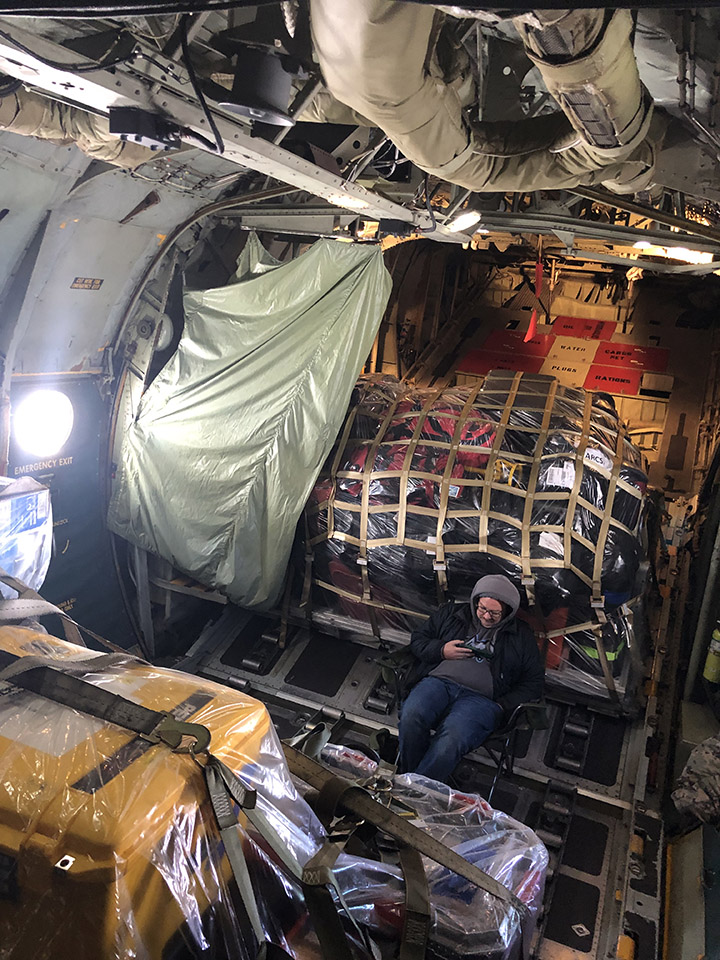
Several mountains of baggage, including scientific instruments and personal luggage, separate us from the less-well-heated economy cabin, which was probably reserved for graduate students, though we are far too collegial a group to check seat assignments. As we head north and east, the landscape out the window is vast, entirely gray-scale, and unforgiving: sea ice with streaks and patches of open water as far as one can see in every direction.
About halfway through the flight, we cross the Arctic Circle. Here the scene is often reduced to pure gray, and one cannot tell what is sea ice, snow, or cloud. This is the challenge we have long faced when attempting to interpret our remote sensing imagery; now, as an early gift of the expedition, I experience it directly.

May 26, 2024

The site is halfway between Washington and Moscow. Most or all of the buildings were prefabricated, brought here by ship in the summer, and mounted on stilts due to the permafrost. Some rough grasses are the only apparent vegetation.
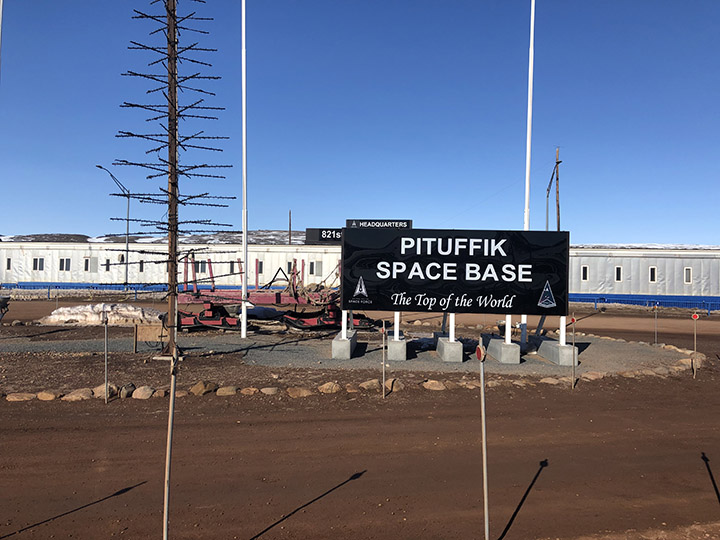
In some ways, the base is well appointed. There is a sports center with an abundance of every conceivable exercise machine, also a tanning machine and a perpetual pool, a huge gym, and a yoga room. There is a recreation center with a movie theater, a lounge area with free apples, tea, and coffee, a game room that is more like an arcade with multiple video machines, and a craft center that has sewing machines (including a state-of-the-art Serger), rock cutting and polishing machines, computer graphics, and printers.
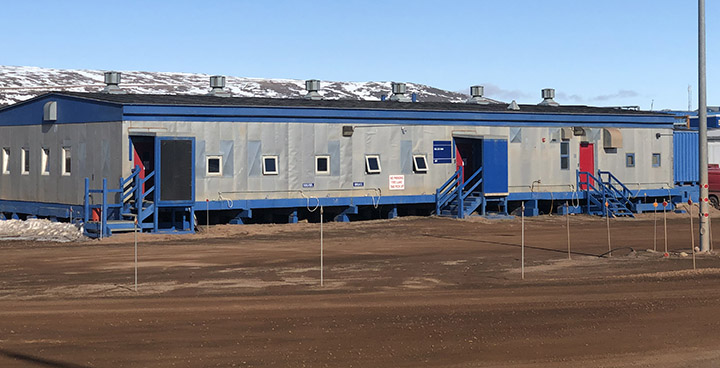
This is a remote place. The site is protected by a thousand kilometers of ice in nearly all directions, and the only ways to get here are by air or by boat for a couple of months of the year, when the sea is not frozen. With full daylight all day and “night,” the times-of-day are marked only by artificial clocks; the natural ones are essentially absent.
May 27, 2024
This was mostly a flight-planning day, getting ready for the first science flight of the campaign. It turned cold, windy, and snow fell today. This was more like what I expected but didn’t experience during the first two days. But now it is sunny again, around 6 p.m., and near-freezing, so there is still standing water on the roadways, and we are past the season when it is safe to walk on the ice-bound bay. The severe environment calls for some specific adaptations.
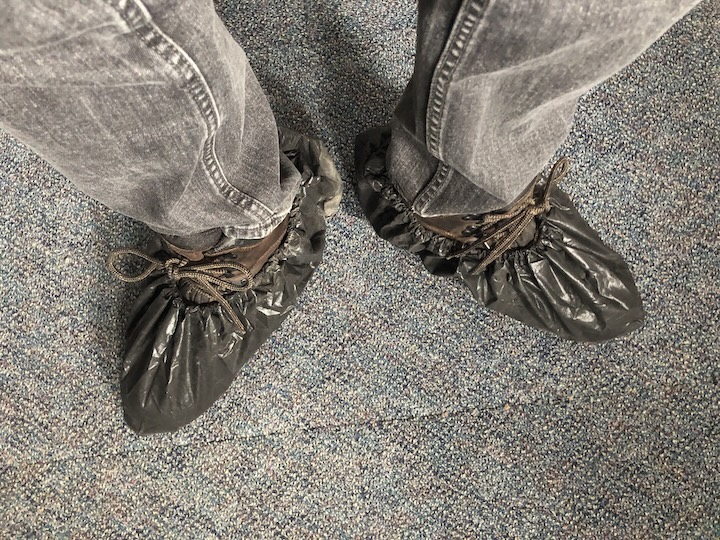
For example, the outer doors have latches that seal upward, so a bear pushing down on the handle will be unable to open the door. The walkways are made of open steel grids, so snow and mud will drip through. Boots are to be brushed before entering buildings, and plastic boot covers are provided in an effort to limit the amount of dirt that is tracked in.
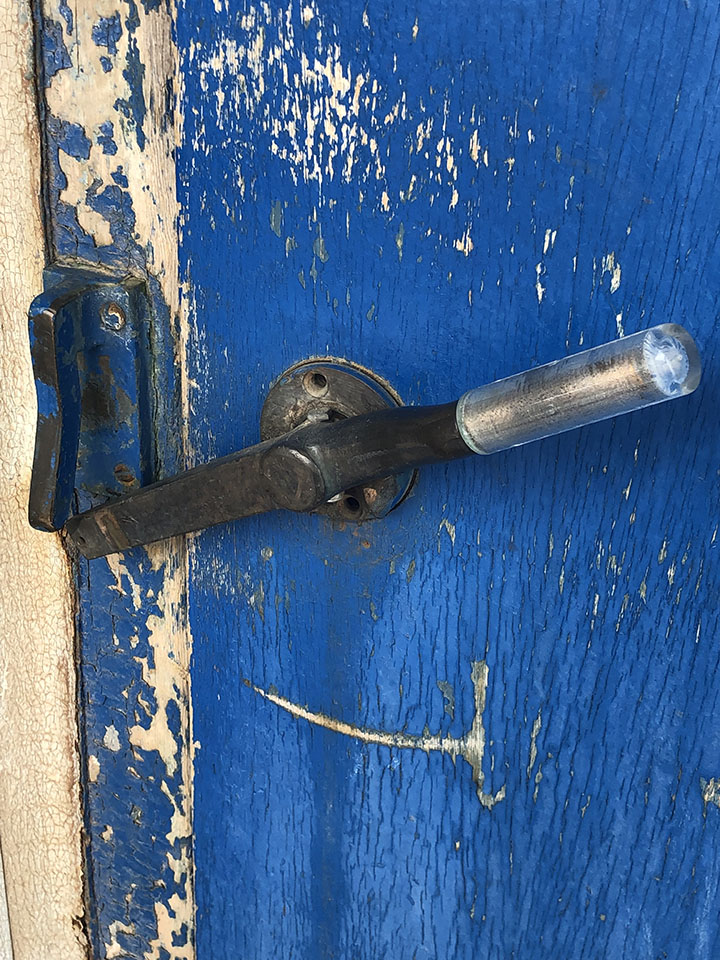
I took a late-night walk. It’s daylight anyway, though overcast, windy, cold, and flurrying. Pretty much what I expected here.
The power went out twice today. Everything goes down, including the internet. I’m trying to keep everything charged, in case it happens again. Today’s weather represents “Condition Alpha” for storm warnings. That means just be on alert, in case things change. Condition Bravo means you cannot go outdoors without a buddy, or drive alone without a radio. Condition Charlie means you can’t walk out at all; there is a base taxi for urgent movement. Condition Delta: shelter in place.
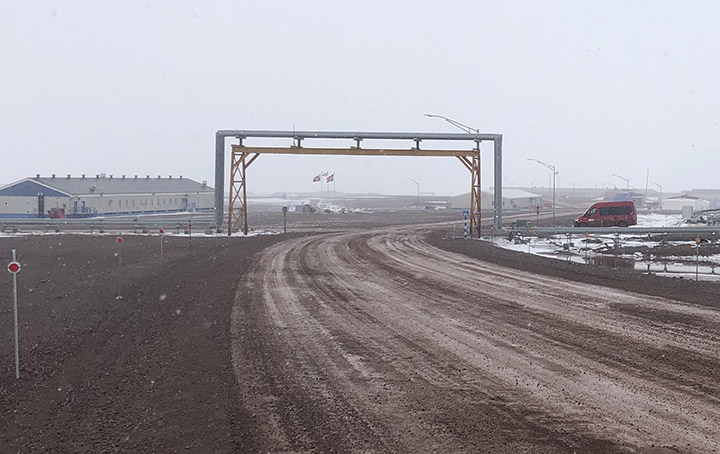
The pipes are all above-ground because of the freeze-thaw cycle that would destroy the pipes. I guess they must be heated and insulated. They cross the road by going overhead.
Car and truck engines must be heated to avoid freezing and cracking. So, many of the buildings have power cords hanging out in front to run electric engine-block heaters. I didn’t take the last picture quite at midnight, but the scene doesn’t change much during the night.
I think I mentioned that it is mud season here. This is no joke. The place has a very industrial feel, and the only place to walk is on the mud roads. I’ve heard it will get worse as the mud deepens, and mosquitoes come out. Something to look forward to…
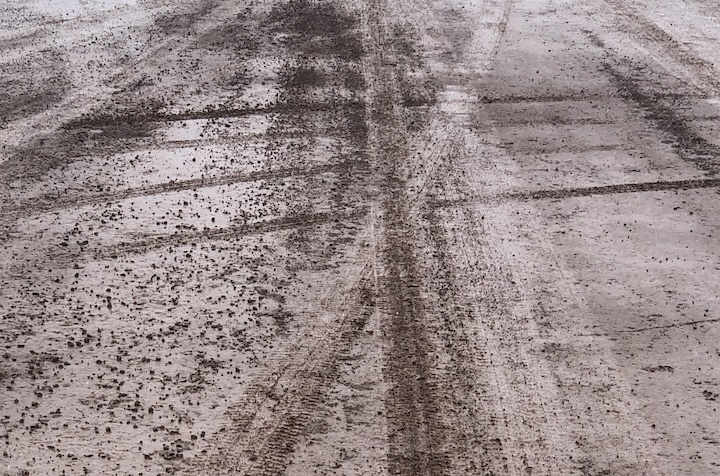
May 28, 2024
We had our first flight with the P3 today, and it was far better than I had expected. There was a rare case of cloud-free atmosphere over sea ice in one area north of Greenland where some buoys had been deployed, which allowed for both surface ice and aerosol characterization. Also, a nearly 3-hour run at ~500 feet captured aerosol properties over open water along the northern part of Baffin Bay. Among our objectives are learning the sources and properties of aerosols in the Arctic, their evolution as they age, and their impact on clouds. Others are especially interested in the properties of sea ice as it melts. So, this gives us a start on those objectives.
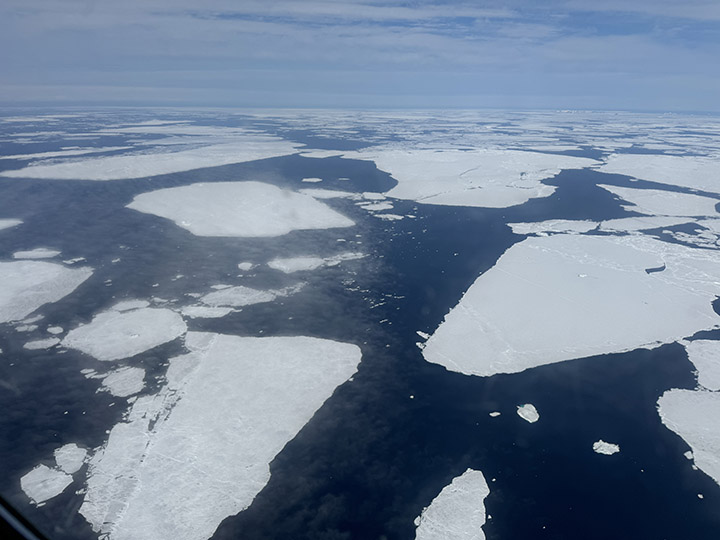
May 29, 2024
The wind is a force of nature. Today it has been blowing at something like 40 miles per hour, with gusts considerably higher. It literally takes your breath away—and this is just Condition Alpha.
Gusts create the sensation of blowing you away. All this under a relatively clear sky, bright sun, just a few clouds. It is somewhat other-worldly to one who has lived a life at lower latitudes. The temperature is only a few degrees below freezing, but the weather today gives new meaning to the term “wind chill.”
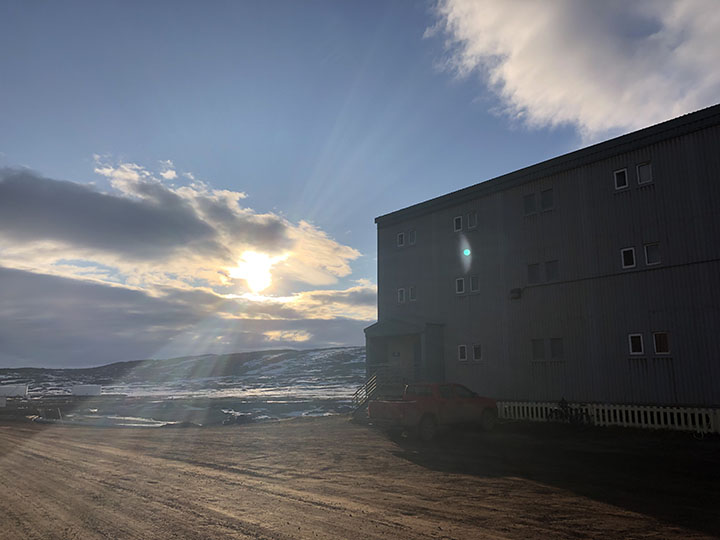
June 1, 2024
Today was an official day off, and in particular, a mental health day for the forecasters. Several of the military folks on the base arranged to take a group of us on a hike over the Greenland Ice Cap. There were 15 of us in five trucks. The trip involved a fair amount of driving on gravel roads in trucks—about half the time driving, half hiking – 5 hours total. The hike itself was about 5 or 6 miles, and we walked around and then on the glacier, though we never did find the Starbucks.

In addition to the stark beauty of the rock fields and ice, the sky is unlike anything we normally see at lower latitudes. The surface is cold, and the atmosphere is no colder (and sometimes is even warmer) than the surface, i.e., it is stably stratified—the “warm” air is already up, so there is not a lot of warm air rising and mixing that typically happens when the surface is heated directly by the Sun.

The glaciers have brought an enormous diversity of stones that litter the ground, and every piece of wood here was carried in from somewhere else. There are little clumps of vegetation, just enough to satisfy the appetites of musk oxen.
So far, I’ve seen Arctic fox (no pictures—they disappeared too quickly), musk ox in the distance, Arctic hare, and snow goose. No polar bears—and no complaints about that.
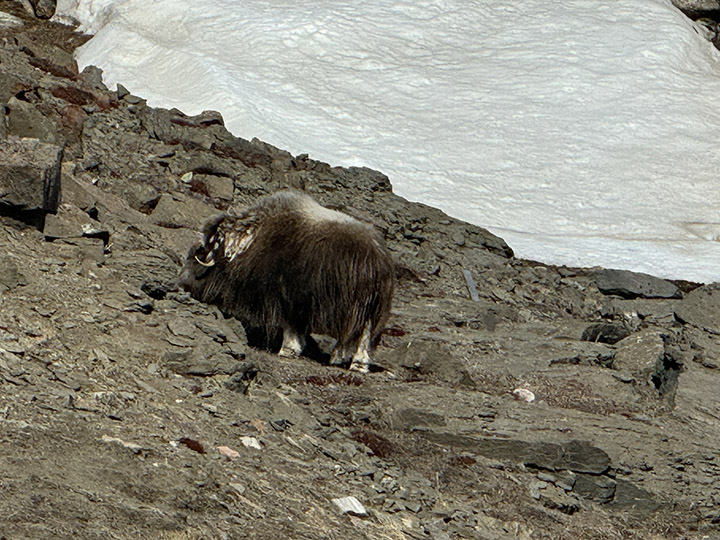
June 7, 2024
This evening I took a long walk out to the ice-bound pier… AND I SAW AN OTTER!!!

June 4, 2024
The Arctic foxes are molting. They were very cute when their coats were all white. Now they are losing their winter coats and turning brown. I did see a couple of full white coats, but was too slow to get a photo.
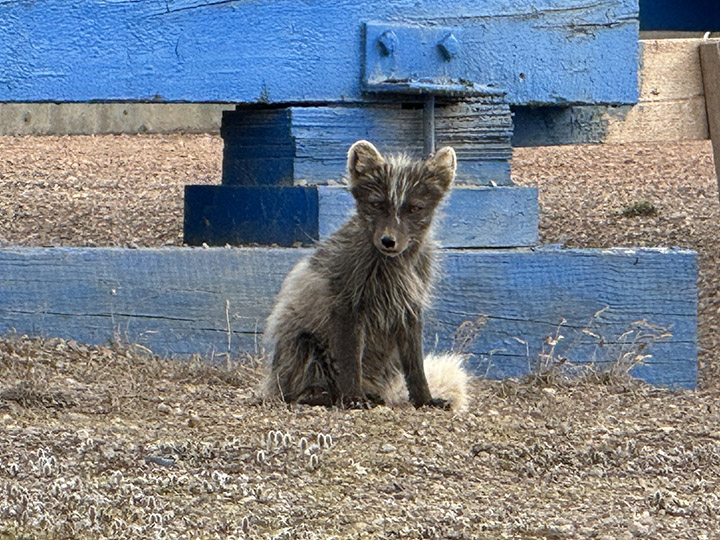
June 8, 2024
The project rented a van, and ten of us went off to climb the Dundas, that imposing rock feature not far from the base, though to get there without walking on thin ice (here the term is not merely a metaphor), one has to drive about 30 minutes over rocky and sometimes quite steep roads around the frozen bay.

The angle of repose is the angle a pile of dry sand (or salt) will make if you dump a bucket of it on the ground. It is generally steep (depends in part on the grain size and shape of the sand particles). Dundas is about 725 feet high; it appears to be the remnant of a glacial moraine—rock pushed here by an advancing ice sheet at least that high, that remained after the ice melted away. It is loose sand and rock, mostly gravel and cobble-sized. The climb up was, frankly, arduous, as there are not a lot of footholds.

The first part was steep enough that going on all fours was necessary in places, and the sand and small rocks would slip easily down the slope as one persevered upward. The final part was up a sheer rock wall that was graced, mercifully, with a sturdy rope. My pictures are lacking for the entire traverse, as all my effort went into the climb itself. I did stop part way up the rock wall to check my life insurance policy.

The view from the top was spectacular, but truthfully, there are so many great vistas in this rugged place that the main reward was accomplishing the ascent itself.
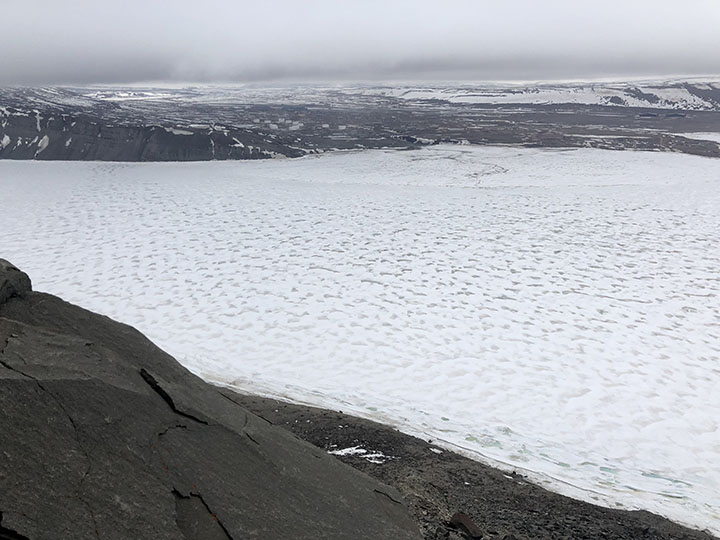
The way down was similarly fraught, except that below the rock wall, I had pretty much no choice but to slide down bit by bit—the loose surface material would give way at every step. So, on my back, lift up my rear, slide a few feet using my boots to stop, and repeat. There was some interesting vegetation on the slope—tiny plants and lichen, which I did photograph. I’m told that some of these plants can be hundreds of years old.
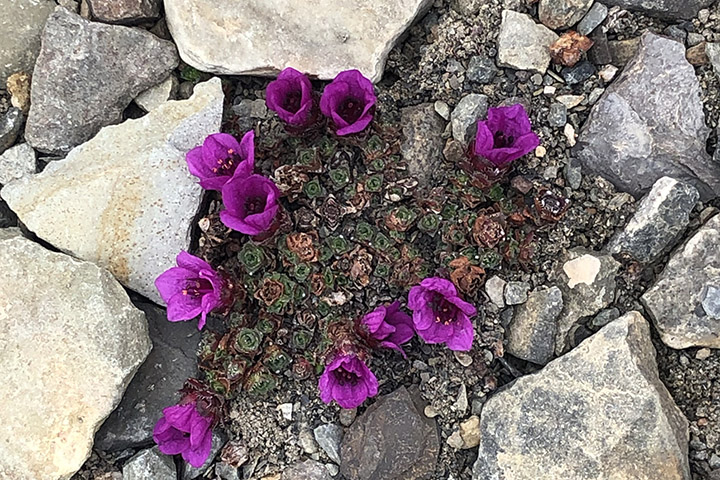
In the distance, we saw some dark spots that the binoculars suggested were seals. (Oh, yes—someone here said that my otter from last night was actually a ring seal; not sure that is authoritative, but…).
June 9, 2024
I agreed to join this afternoon’s walk up the edge of the Greenland Ice Sheet.
The slope is moderate by Dundas standards, and the path is completely snow-covered. The walk up is of course uphill, and a steady wind of 30–40 mph (the katabatic wind), with significantly higher gusts, blows off the ice. This guaranteed that however far we got up the ice sheet, we would certainly be able to make it down, either on foot or airborne.

There were pools of water within ice basins at the base. They look a beautiful shade of blue. We saw this in Alaska as well. I think it must be that ice either absorbs all the longer wavelengths, or it preferentially scatters blue, or both. The optics here are stunning, at least to me. Probably because they are unfamiliar.
One way painters provide a sense of distance in a painting is with “atmospherics,” that is, they increasingly blur the edges of more distant objects to account for light scattering by atmospheric gas and aerosols. Mountain climbers experience the opposite, in the thinner atmosphere, remote objects are sharper than they would in everyday experience, so more distant objects appear closer than they actually are. This is true here in Greenland as well, though we are not at a very high elevation along the coast. I expect the phenomenon in this case is due to a very clean atmosphere.
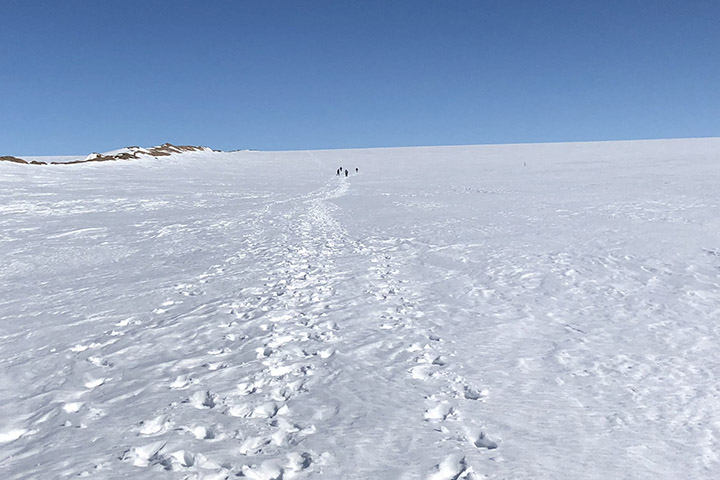
June 11, 2024
Today I got to fly on the P-3. Every satellite scientist should be required to take at least one such flight to see what the Earth is really like. We flew across northern Greenland and over sea ice. In the two weeks since the campaign deployment began, the depth of the sea ice, and the snow upon it, both decreased at those buoys (where it was measured), and, of course, most everywhere else as well.
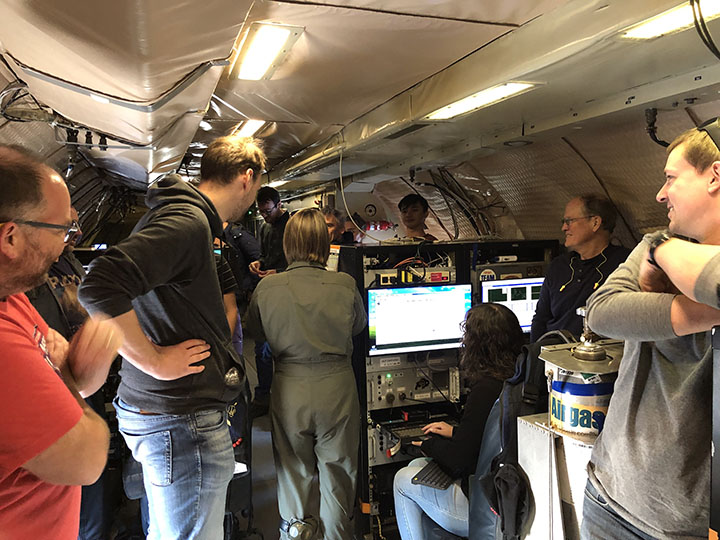
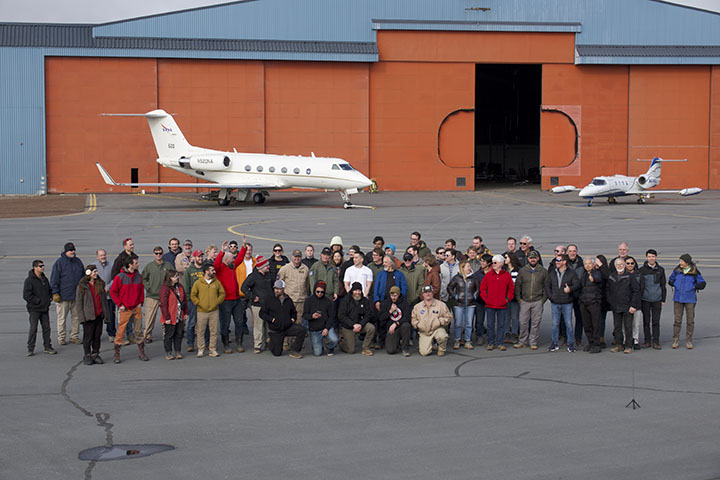
A field campaign is a layered operation. Aircraft flight scientists build, run, and maintain the twenty or so instruments that measure particle composition, gas concentration, cloud properties, surface reflectivity, and upwelling and downwelling energy. They are awake by 4 a.m. to prepare their instruments for flight, worry about power supplies and calibration, then sit on the plane for six or seven hours, noting what they see from their measurements and out the window.

The number of leads (i.e., openings in the ice) has increased in places. We flew at high elevation to survey the area, measure the overall surface topography and reflectance, and sample aerosol layers aloft, then descended to 300 feet above the ice to capture aerosols emanating from the surface. The photos tell an accessible part of the story. The rest must be teased out of the data in the coming months and years. But my ride is over for now—there is an aerosol forecast due tomorrow.

June 12, 2024
It was flurrying this evening, and my walk carried me down toward the pier. But you might be pleased to know, I did not go all the way; several seals have now been seen on the ice at the pier. My otter or seal in the water was the first anyone saw, and although they say it is relatively rare for bears to go near the base, seals are their primary food. I figured, after a long winter hibernation, a bear might not count me as even a light snack, but in consideration that I had already booked my flight home, I turned around before getting very near the water’s edge.
June 14, 2024
I should say that the food here is okay. Better than I expected. Of course, in such circumstances, it pays to begin with low expectations: hardtack, pemmican, and beef jerky. The cafeteria serves a lot of beef and pork, but there is also chicken, a reasonable salad bar, excellent, fresh bread (the highlight in my opinion), always two of THE three kinds of fruit (apples, oranges, and bananas—so yes, they mix apples and oranges), and of course, Danish, at least in the morning.
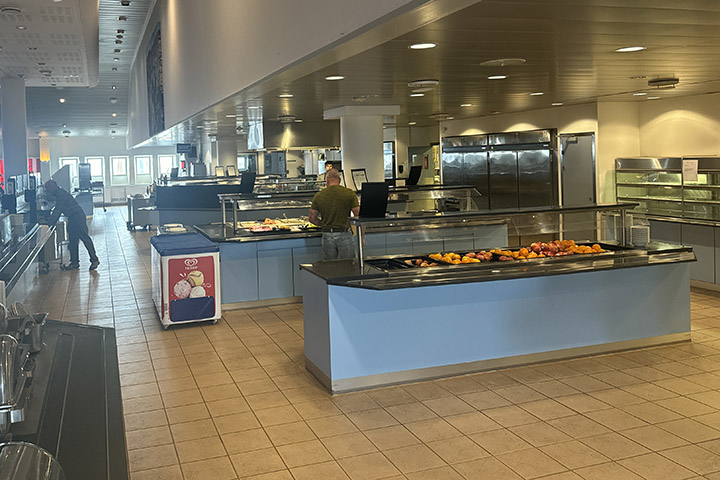
In the evening I took a walk, as usual, and ended up in one of the dozens of prefab buildings on the base, with the suggestive label “Heritage Hall.” The door was not locked, and the lights turned on as you entered each room. The place is a sort of museum, a repository for things discarded from the 1950s and 60s.
They have a computer punch-card machine, a vacuum-tube TV set, and a radar scope you will recognize from science-fiction movies. Also some notebooks with photos of the army’s Camp Tuto (now abandoned—only remnants of the airfield remain) and the presumptive city “Camp Century” they built into the ice in the 1950s. The walls flowed at glacial speed but ultimately collapsed.
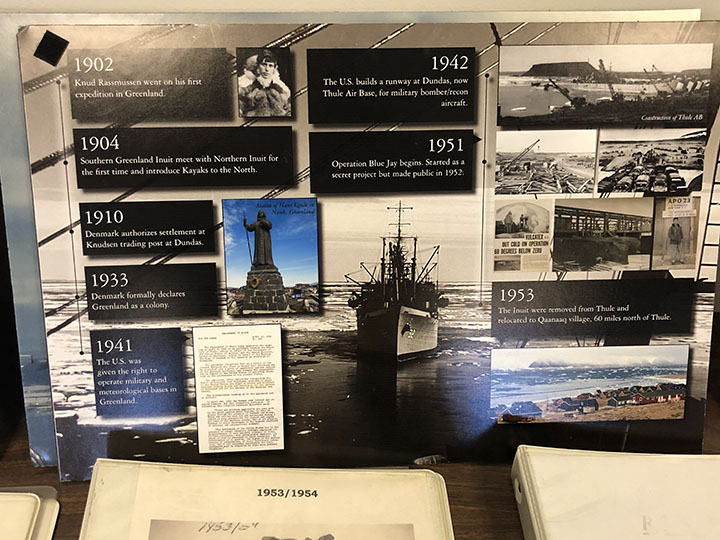
Thule base was established in 1951, succeeding three waves of Inuit who inhabited the area, apparently beginning 4,500 years ago. The most recent came around 900 CE, met the Norse about 100 years later, and were moved to a new village 60 miles to the north in 1953. There is even a Life Magazine cover showing ships delivering material to the base in September 1952.

Ralph Kahn, an emeritus research scientist at NASA’s Goddard Space Flight Center now at the Laboratory for Atmospheric and Space Physics at the University of Colorado Boulder, spent three weeks at Pituffik Space Base in northern Greenland in the summer of 2024. He was one of dozens of scientists who participated in ARCSIX (Arctic Radiation-Cloud Aerosol-Surface Interaction Experiment), a NASA-sponsored field campaign that made detailed observations of clouds and atmospheric particles to better understand the processes that affect the seasonal melting of Arctic sea ice. These excerpts from his emails home to family provide a glimpse of what life was like on one of the world’s most northern scientific outposts in the world. Photos were taken by Kahn or Gary Banzinger, a NASA videographer who also participated in the campaign. Kahn, an atmospheric scientist, worked with colleagues to provide daily aerosol forecasts that were used to help plan flights.
Hi there,
For this last blog post of the season, we summarize our work with numbers and photos to give you an idea of our field camp and the life/work on the ice sheet.
This summer fieldwork can be summarized as:
Weather and camping:
Science:
And that is about it for the 2015 fieldwork! Our team will spend fall working on the data at their labs, and we will be back into the field next year in the spring (May/June).
We hope you are enjoying the blog posts and we would like to thank you all very much for following this work! See you all next year!
Best wishes,
Clem

Anatoly posing next to the iWS from the University of Utrecht before and after backfilling the 2-feet deep snow pit.
Our entire team left Greenland in the last week or so and I am writing this blog post from a warm place. In this post, I will describe the additional measurements taken by the team and show a few photos to illustrate how these data were taken. As reminder, the seismic data collection was explained by Lynn here, and hydrologic measurements described by Olivia in the previous post. Here, we will present the ground-penetrating radar collection, the magnetic resonance soundings, the intelligent weather station set up, and the monitoring of the firn temperature and water-table level.
The ground-penetrating radar (GPR) was used first to decide where to extract the firn cores, do the hydrological tests, and set up magnetic soundings and seismic surveys. During the first days of the fieldwork, we did not have the snowmobile on site, so we made a small sled with a piece of foam that we could drag. It had the advantage on being light and fast to set up.
The GPR profile allows us to derive the depth of the water table below the snow surface. The water table corresponds to the top of the firn aquifer and is represented in the GPR data by a bright internal horizon (see GPR profile on photo 2, bottom part). In the summer time, we expected the wet firn above the aquifer to prevent the electromagnetic signal from penetrating to the water table but we were still able to image the water table. However, the correction from two-way-travel time to depth will need to take into account the presence of near surface water as it slows down the electromagnetic signal. To determine the water-table depth and adjust our dielectrical model, the magnetic resonance soundings will be important as it provide a direct measurement of the water volume.

GPR survey on the snowmobile with the mountains at the background (Photo Credit: Nick Schmerr). At the bottom, example of GPR profile collected above the water table (Miège et al., 2015, JGR in review). The bright reflector represents the water table.
Magnetic resonance sounding (MRS) is a non-invasive technique which captures the magnetic resonance signal generated only by water molecules in the subsurface. Anatoly, a researcher from LTHE in Grenoble (FR), accepted our invitation to use his instrument over the Greenland firn aquifer. After successful initial testing in the spring, we performed several additional soundings this summer. The setup consists in a square loop about 80m long, made of wire. At one corner of the loop, all the instruments are hooked up, powered with 12V batteries.

Anatoly is laying on a tarp finishing connecting the wires to the instruments. The bamboo stick marks one corner of the loop.
One MRS takes about 1 hour to setup including walking the wire for installing the square loop. The measurement takes between 2 and 3 hours, it is always a good idea to go back to the tent for a hot drink in the meantime.
The last part of this fieldwork was to set up sensors to monitor the surface conditions on the ice sheet as well as the shallow subsurface (snow and firn) throughout the year, when we are not in the field. First, we moved the intelligent weather station (iWS) to a new location, about 20 km north. This iWS was initially installed in the spring of 2014 and we decided to move it at the new fieldwork location located directly upstream of Helheim Glacier.

iWS developed by our colleagues from the University of Utrecht in the Netherlands. On the left, iWS at the old location and on the right, the iWS left at its new location.
To look at the firn and water thermal properties we also installed a string of 50 temperature sensors from the surface to the top of the aquifer, within the aquifer, and beyond in the ice. We also dropped a pressure sensor to measure the vertical fluctuations of the water table from the snow surface. Finally, we had the chance to use one of the compaction devices designed by our colleagues from the University of Colorado. The Colorado team is setting up the largest snow/firn compaction network on the Greenland ice sheet. If you are interested to know more about their work, follow this link. The compaction device consists of a wire with one end anchored at depth in the firn. The other end of the wire, located at the surface, reels back on a spool as the surface is lowering with snow being compacted.

iWS standing next to the firn and water level logging station with our snowmobile in between for scale.
One of the logging stations was set up in April this year, and surprise, we got some visitors! They left us a note in the logging station case. It was a fun and unexpected moment as visitors are very rare on the ice sheet. Also it would be difficult to spot such a tiny station unless you go right by it, due to the surface undulations. These visitors are researchers from the University of Berlin, Germany. They are crossing the ice sheet between Tasiilaq and Ilulissat, repeating a route that a Swiss explorer, Alfred de Quervain, took in 1912.
Hi to them, and best of luck in their crossing! If you are interested to know more of their adventure, they left us their website link.
That is all for this blog post, stay tuned because we’ll send one last post for this summer season to wrap up and show more photos.
One of the great things about this collaborative research project is that each researcher uses very different techniques to study the firn aquifer and we will put all our results together to get the most comprehensive understanding of the aquifer. We use science techniques that look at different aspects and scales of the aquifer, from ice cores and water wells focused on single points on the ice sheet to radar, MRS, and seismic techniques that look at meters to hundreds of meters of spatial coverage. Each technique yields different, yet complementary data, particularly since we were able to use each technique at the same locations.
We were incredibly lucky with the field conditions for this season and, as a result, the hydrology work went very well. The weather was the complete opposite of what we experienced in the spring. We had warm sunny days with almost 24 hours of daylight. In the spring we had issues with water freezing in the tubing we used to take water samples of the aquifer. It was warm enough that we had no problem with that this time.
Because of the good weather, we were also able to drill into the aquifer at two sites for the hydrology work. We took samples and measurements that will show us how the aquifer changes spatially. We took water samples, measured the water level of the aquifer, and did several tests to measure how quickly water moves through the firn.
We also took samples of ice cores and water at different depths that we will measure tritium (an isotope of hydrogen that was released into the atmosphere as a product of nuclear weapons testing) in to determine how old the firn and water at each depth is. Tritium in the atmosphere was most concentrated in the 1960s and has been decreasing since them. We can measure the amount of tritium in a water sample to see how old it is. Annual layers of snow and ice preserve the atmospheric history of tritium in the atmosphere. As you drill ice cores from greater depths, you move back in time. In the spring we were really close to sampling the tritium peak so we are hoping that we drilled our ice cores deep enough to sample the peak this time.
My next steps include laboratory analysis of the samples I collected. I am looking forward to getting and sharing results soon!
After 18 long days of successful science and arctic adventures on the ice sheet, we were finally done and ready to head back to civilization. On the morning of August 13th, our expected pull out date, we received bad news from the pilots – they were not even in Kulusuk due to weather delays the day before. They planned to travel that morning and the next day to arrive so pickup should be in the coming days, however to call back later for an update. We went on with our day making pancakes and playing UNO because all the work and all the packing was complete, what else are scientists to do when all the science is done? We called the pilots in the afternoon for an update and got the best news possible – one pilot had arrived and was on his way to pick us all up that afternoon!
We headed back to Kulusuk just in time for dinner and had three sling loads come in the following days (August 14 and 15). Huge thank-you to our fantastic pilots Diddi and Johannes for the smoothest and quickest field put in/pick up so far.
This field season could not have been more rewarding and efficient. We completed all our our science goals and even got some extra data. In the field, we were able to visit all four sites as well as check out some other interesting spots near camp and near the crevasses (though still at a very safe distance!). These extra sites were chosen based on ground based radar data processed and provided by Clem in the field. The field team even got overlapping measurements of radar, seismics, MRS, hydrology, and ice core data from the same site sometimes simultaneously!

When science overlaps — Taking a seismic shot while drilling for ice cores and taking hydrological measurements of the aquifer!
The weather was perfect almost every day, we only had two days of clouds and a bit of snow overnight. The winds would moderate in the morning and generally die down in the afternoon, but wonderful conditions for working as it was not too cold. This heat would cause a bit of melt at the surface in the afternoon with no winds which would make it a bit slushy, but work was always manageable. We took no rest days, as the weather did not permit us with any spending all of our time working, some days lasting 11-12 hours. However, we do not complain about the long hours, we take this time to work in great conditions as a huge gift not often seen in Southeast Greenland especially after our last field season.
As for the seismic portion of the mission, we are very happy to report that we were absolutely successful on all fronts. Due to some logistical issues, we decided to use a smaller version of the streamer cables, the one we brought in weighs only 65 pounds instead of the 350 pound original one which also required a snowmobile to tow. We ended up doing about seventeen lines in total at 6 different sites combined. One line corresponds to a 115 meter cable with 5 meter spacing on the geophones. We took shots from 80 meters before the line and 80 meters after the line as well as on the line at ten meter spacing allowing us a much finer spatial resolution for the incoming P-waves to determine the first arrivals. That translates to over 1500 manual hammer shots and almost 600 data files. We had some very sore backs some days but the team really pitched in to help out, even slightly bending the steel hammer plate by the end! We cannot wait to analyze the data and begin looking at results.
Here’s a video from the field showing how we collected the seismic measurements: